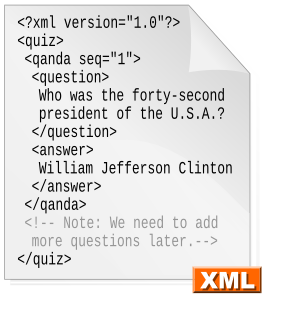Enterprise JavaBeans (EJB) is one of several Java APIs for modular construction of enterprise software. EJB is a server-side software component that encapsulates business logic of an application. An EJB web container provides a runtime environment for web related software components, including computer security, Java servlet lifecycle management, transaction processing, and other web services. The EJB specification is a subset of the Java EE specification.
The Java Transaction API (JTA), one of the Java Enterprise Edition APIs, enables distributed transactions to be done across multiple X/Open XA resources in a Java environment. JTA is a specification developed under the Java Community Process as JSR 907. JTA provides for:
The Java Message Service (JMS) API is a Java message-oriented middleware API for sending messages between two or more clients. It is an implementation to handle the producer–consumer problem. JMS is a part of the Java Platform, Enterprise Edition, and was defined by a specification developed at Sun Microsystems, but which has since been guided by the Java Community Process. It is a messaging standard that allows application components based on Java EE to create, send, receive, and read messages. It allows the communication between different components of a distributed application to be loosely coupled, reliable, and asynchronous.
Java Platform, Standard Edition is a computing platform for development and deployment of portable code for desktop and server environments. Java SE was formerly known as Java 2 Platform, Standard Edition (J2SE).
The Java Community Process (JCP), established in 1998, is a formalized mechanism that allows interested parties to develop standard technical specifications for Java technology. Anyone can become a JCP Member by filling a form available at the JCP website. JCP membership for organizations and commercial entities requires annual fees – but is free for individuals.

JavaServer Faces (JSF) is a Java specification for building component-based user interfaces for web applications and was formalized as a standard through the Java Community Process being part of the Java Platform, Enterprise Edition. It is also a MVC web framework that simplifies construction of user interfaces (UI) for server-based applications by using reusable UI components in a page.
Java Management Extensions (JMX) is a Java technology that supplies tools for managing and monitoring applications, system objects, devices and service-oriented networks. Those resources are represented by objects called MBeans. In the API, classes can be dynamically loaded and instantiated. Managing and monitoring applications can be designed and developed using the Java Dynamic Management Kit.
The Web Services Invocation Framework (WSIF) supports a simple Java API for invoking Web services, no matter how or where the services are provided. The framework allows maximum flexibility for the invocation of any Web Services Description Language (WSDL)-described service.
BeanShell is a Java-like scripting language, invented by Patrick Niemeyer. It runs in the Java Runtime Environment (JRE) and uses a variation of the Java syntax, in addition to scripting commands and syntax.
The JavaServer Pages Standard Tag Library (JSTL) is a component of the Java EE Web application development platform. It extends the JSP specification by adding a tag library of JSP tags for common tasks, such as XML data processing, conditional execution, database access, loops and internationalization.

GlassFish is an open-source application server project started by Sun Microsystems for the Java EE platform and now sponsored by Oracle Corporation. The supported version is called Oracle GlassFish Server. GlassFish is free software, dual-licensed under two free software licences: the Common Development and Distribution License (CDDL) and the GNU General Public License (GPL) with the classpath exception.
RMI-IIOP denotes the Java Remote Method Invocation (RMI) interface over the Internet Inter-Orb Protocol (IIOP), which delivers Common Object Request Broker Architecture (CORBA) distributed computing capabilities to the Java platform. It was initially based on two specifications: the Java Language Mapping to OMG IDL, and CORBA/IIOP 2.3.1.
The Java API for XML Web Services (JAX-WS) is a Java programming language API for creating web services, particularly SOAP services. JAX-WS is one of the Java XML programming APIs. It is part of the Java EE platform.
The Java Persistence API (JPA) is a Java application programming interface specification that describes the management of relational data in applications using Java Platform, Standard Edition and Java Platform, Enterprise Edition.

OpenJPA is an open source implementation of the Java Persistence API specification. It is an object-relational mapping (ORM) solution for the Java language, which simplifies storing objects in databases. It is open-source software distributed under the Apache License 2.0.
JAX-RS: Java API for RESTful Web Services (JAX-RS) is a Java programming language API spec that provides support in creating web services according to the Representational State Transfer (REST) architectural pattern. JAX-RS uses annotations, introduced in Java SE 5, to simplify the development and deployment of web service clients and endpoints.
Bean Validation defines a metadata model and API for JavaBean validation. The metadata source is annotations, with the ability to override and extend the meta-data through the use of XML validation descriptors.
The JBoss Enterprise Application Platform is a subscription-based/open-source Java EE-based application server runtime platform used for building, deploying, and hosting highly-transactional Java applications and services. The JBoss Enterprise Application Platform is part of the JBoss Enterprise Middleware portfolio of software. Because it is Java-based, the JBoss application server operates across platforms; it is usable on any operating system that supports Java. The JBoss Enterprise Application Platform was developed by JBoss, now a division of Red Hat.





